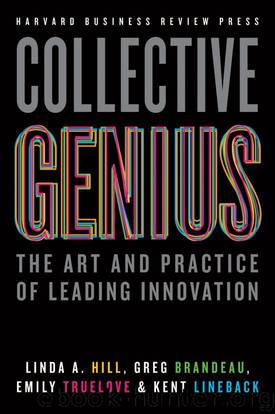Collective Genius: The Art and Practice of Leading Innovation by Linda A. Hill & Greg Brandeau & Emily Truelove & Kent Lineback

Author:Linda A. Hill & Greg Brandeau & Emily Truelove & Kent Lineback
Language: eng
Format: mobi
ISBN: 9781422130025
Publisher: Harvard Business Review Press
Published: 2014-05-12T14:00:00+00:00
By diversity, we mean people who think differently.
By conflict, we mean cognitive conflict not interpersonal conflict, that is, conflict over ideas and approaches, as opposed to personalities; conflict aimed at learning and improving, not winning, losing, or dominating.3
Diversity
When people think of diversity today, they typically focus on demographic diversity—differences in nationality, culture, ethnicity or race, and gender. But just because people look different doesn't mean they'll have divergent points of view.4 Different life experiences and personal identities may lead to different outlooks, but not necessarily.
Creative abrasion requires a different kind of diversity: intellectual diversity. For innovative problem solving, you want to bring together people who think differently, people who have different skills, knowledge, working and thinking styles, and different preferences for how they gather, process, and assimilate data.5
John Seely Brown, the former head of Xerox PARC, contends that innovation flows from the friction of multiple views coming together. “Breakthroughs often appear,” he says, “in the white space between crafts … These crafts start to collide, and in that collision radically new things start to happen.”6
Not only does diversity lead to innovation, it also attracts talented individuals. According to growing evidence, such people gravitate to communities that “provide the stimulation, diversity, and richness of experiences that are wellsprings of creativity.” The reasons are clear. “Diversity means ‘excitement’ and ‘energy.’ Creative-minded people enjoy a mix of influences … a place seething with the interplay of cultures and ideas … They also happen to be qualities conducive to innovation, risk-taking, and the formation of new businesses.”7
Pixar clearly was such a community. It successfully bridged three different worlds—technical, creative, and business. Other studios were usually driven by one or the other, but not Pixar. It treated people across these worlds as peers and colleagues valued for their different but equally valuable perspectives. This sense of mutual respect, trust, and influence created a fertile context for the kind of idea sparring necessary for creative abrasion. “It was clear to me,” said Brandeau, “that Pixar hired artists and technologists in as peers. Everyone could talk to anyone else at the studio. Many of these people were the best in the world at what they did—and they were all focused on pooling their talents to achieve a shared goal: make terrific films.”
Even within the key groups inside Pixar, leaders actively sought diversity. In systems, for example, Brandeau wanted more than technology whizzes. He wanted people with a mosaic of different talents, sensibilities, personalities, subject-matter expertise, backgrounds, age, and so on. Many of those people did not come to Pixar with traditional technology backgrounds. They included a cultural anthropologist who had worked with Jane Goodall, someone who had managed concessions at a major state fair, an erstwhile music producer and video jockey, and even a professional cheerleader. Regardless of their backgrounds, they all thought of themselves as filmmakers.
The two systems people we met in the story, Anne Pia and Chris Walker, were good examples. They shared the same job running the RenderFarm but brought to it different backgrounds and skills.
Download
This site does not store any files on its server. We only index and link to content provided by other sites. Please contact the content providers to delete copyright contents if any and email us, we'll remove relevant links or contents immediately.
Bad Blood by John Carreyrou(6275)
Rich Dad Poor Dad by Robert T. Kiyosaki(6175)
Principles: Life and Work by Ray Dalio(5961)
Playing to Win_ How Strategy Really Works by A.G. Lafley & Roger L. Martin(5500)
Management Strategies for the Cloud Revolution: How Cloud Computing Is Transforming Business and Why You Can't Afford to Be Left Behind by Charles Babcock(4438)
The Confidence Code by Katty Kay(4038)
Thinking in Bets by Annie Duke(3996)
American Kingpin by Nick Bilton(3507)
Delivering Happiness by Tony Hsieh(3281)
Project Animal Farm: An Accidental Journey into the Secret World of Farming and the Truth About Our Food by Sonia Faruqi(3018)
The Power of Habit by Charles Duhigg(2966)
Brotopia by Emily Chang(2896)
Mastering Bitcoin: Programming the Open Blockchain by Andreas M. Antonopoulos(2891)
The Tyranny of Metrics by Jerry Z. Muller(2846)
I Live in the Future & Here's How It Works by Nick Bilton(2844)
The Marketing Plan Handbook: Develop Big-Picture Marketing Plans for Pennies on the Dollar by Robert W. Bly(2793)
The Content Trap by Bharat Anand(2778)
Building a StoryBrand by Donald Miller(2754)
Applied Empathy by Michael Ventura(2750)
